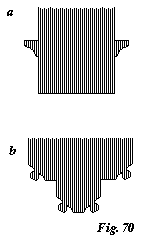DECORATION XXVIII. ARCHIVOLT, APERTURE 391
voussoir is to annihilate the cornice, and receive an ornament of its own outline, and entirely limited by its own joints; and yet this may be seen in the very early apse of Murano.1
§ 7. The most usual condition, however, is that unity of the two members above described, § 5, and which may be generally represented by the archivolt section a, Fig. 70; and from this descend a family of Gothic archivolts of the highest importance. For the cornice, thus attached to the arch, suffers exactly the same changes as the level cornice, or capital; receives, in due time, its elaborate ogee profile and leaf ornaments, like Fig. 8 or 9 of Plate 15; and, when the shaft loses its shape, and is lost in the later Gothic jamb, the archivolt has influence enough to introduce this ogee profile in the jamb also, through the banded impost: and we immediately find ourselves involved in deep successions of ogee mouldings in 
§ 8. This, then, will be the first great head under which we shall in future find it convenient to arrange a large number of archivolt decorations.2 It is the distinctively Southern and Byzantine form, and typically represented by the section a, of Fig. 70; and it is susceptible of almost every species of surface ornament, respecting which only this general law may be asserted: that, while the outside or vertical surface may properly be decorated, and yet the soffit or under surface left plain, the soffit is never to be decorated, and the outer surface left plain. Much beautiful sculpture is, in the best Byzantine buildings, half lost by being put under soffits; but the eye is led to discover it, and even to demand it, by the rich chasing of the outside of the voussoirs.
1 [Described in detail in the next volume, ch. iii. and appendix 6.]
2 [See Stones of Venice, vol. iii., “Final Appendix,” No. iv.]
[Version 0.04: March 2008]